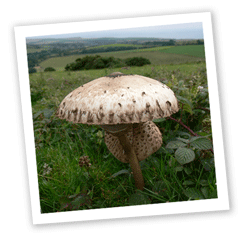|
|
fungi
Find out more
Habitat Action Plans
Priorities for
Woodland Biodiversity on the Isle of Wight (2003)
Woodland HAP (Revised 2009)
External links
Visit fungus.org.uk for many
links to fungus sites.
The majority of mushrooms and toadstools (which are the visible fruiting bodies of the organisms known as as fungi) on the Isle of Wight usually appear in the autumn, although quite a few may be seen at other times of year. They are actually only a very small part of the fungus.
 They
are one of the ways in which fungi reproduce themselves and they exist
just to produce spores. The spores, when released to a suitable habitat,
send out thread-like structures called hyphae, gradually building up
a network of these threads called a mycelium. The mycelium can eventually
become vast, covering huge areas of land. It absorbs the food it needs
from its surroundings. Without fungi, life on earth as we know it would
not exist. They play a vital role in decomposing dead organisms and returning
the resulting nutrients to the soil for plants to reuse. They are also
vitally important for the growth of many plants and in particular trees,
which may require the contributions from their mycorrhizal fungi in order
to flourish.
They
are one of the ways in which fungi reproduce themselves and they exist
just to produce spores. The spores, when released to a suitable habitat,
send out thread-like structures called hyphae, gradually building up
a network of these threads called a mycelium. The mycelium can eventually
become vast, covering huge areas of land. It absorbs the food it needs
from its surroundings. Without fungi, life on earth as we know it would
not exist. They play a vital role in decomposing dead organisms and returning
the resulting nutrients to the soil for plants to reuse. They are also
vitally important for the growth of many plants and in particular trees,
which may require the contributions from their mycorrhizal fungi in order
to flourish.
Fungi can be found in just about any habitat, from sea water to freshwater, in soil, on plants and animals, on human skin and even growing on microscopic crevices in CD-ROM disks! In the Island's countryside, woods and meadows are the best places to go hunting for fungi. Woods are particularly good places to look, as over 80% of fungi are associated with trees or plants. The association benefits both the fungi and the trees. This type of association between fungi and the roots of plants such as trees, is known as a mycorrhiza.
The fruiting bodies of fungi provide specialist habitats for a huge number of invertebrates. The greatest number are beetles and their larvae, but certain kinds of moth and fly larvae also take advantage of this source of food. Many of them can be found on a wide range of fungi, but some may only be found in particular places. For example, a small black beetle (Dorcatoma ambjoerni), occurs only in the fruiting bodies of a particular kind of bracket fungus, growing inside hollow beech trees. Bracket fungi are popular habitats for insects to develop in because they tend to last longer than other fungal fruiting bodies. This allows more time for the insect to develop from egg to adult.
| home | partnership | habitats | species | biodiversity opportunity areas | benefits of biodiversity |
biodiversity & you | advice | walks & events | library | contact |